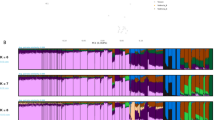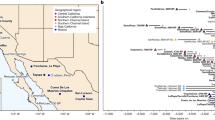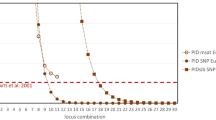Abstract
The Basques are a culturally isolated population, living across the western border between France and Spain and speaking a non-Indo-European language. They show outlier allele frequencies in the ABO, RH, and HLA loci. To test whether Basques are a genetic isolate with the features that would make them good candidates in genetic association studies, we genotyped 123 SNPs in a 1-Mb region in chromosome 22 in Basque samples from France and Spain, as well as in samples from northern and southern Spain, and in three North African samples. Both Basque samples showed similar levels of heterozygosity to the other populations, and the decay of linkage disequilibrium with physical distance was not different between Basques and non-Basques. Thus, Basques do not show the genetic properties expected in population isolates.
Similar content being viewed by others
Log in or create a free account to read this content
Gain free access to this article, as well as selected content from this journal and more on nature.com
or
References
Laan M, Paabo S : Mapping genes by drift-generated linkage disequilibrium. Am J Hum Genet 1998; 63: 654–656.
Calafell F, Bertranpetit J : Principal component analysis of gene frequencies and the origin of Basques. Am J Phys Anthropol 1994; 93: 201–215.
Bertranpetit J, Sala J, Calafell F, Underhill PA, Moral P, Comas D : Human mitochondrial DNA variation and the origin of Basques. Ann Hum Genet 1995; 59 (Part 1): 63–81.
Salas A, Comas D, Lareu MV, Bertranpetit J, Carracedo A : mtDNA analysis of the Galician population: a genetic edge of European variation. Eur J Hum Genet 1998; 6: 365–375.
Rosser ZH, Zerjal T, Hurles ME et al: Y-chromosomal diversity in Europe is clinical and influenced primarily by geography, rather than by language. Am J Hum Genet 2000; 67: 1526–1543.
Alonso S, Flores C, Cabrera V et al: The place of the Basques in the European Y-chromosome diversity landscape. Eur J Hum Genet 2005; 13: 1293–1302.
Adams SM, Bosch E, Balaresque PL et al: The genetic legacy of religious diversity and intolerance: paternal lineages of Christians, Jews, and Muslims in the Iberian Peninsula. Am J Hum Genet 2008; 83: 725–736.
Comas D, Calafell F, Benchemsi N et al: Alu insertion polymorphisms in NW Africa and the Iberian Peninsula: evidence for a strong genetic boundary through the Gibraltar Straits. Hum Genet 2000; 107: 312–319.
Li JZ, Absher DM, Tang H et al: Worldwide human relationships inferred from genome-wide patterns of variation. Science 2008; 319: 1100–1104.
González-Neira A, Ke XY, Lao O et al: The portability of tagSNPs across populations: a worldwide survey. Genome Res 2006; 16: 323–330.
Morcillo-Suarez C, Alegre J, Sangros R et al: SNP analysis to results (SNPator): a web-based environment oriented to statistical genomics analyses upon SNP data. Bioinformatics 2008; 24: 1643–1644.
Schneider S, Roessli D, Excoffier L : Arlequin 2.000: a software for population genetic data analysis. Switzerland: Genetics and Biometry Laboratory, University of Geneva, 2000.
de Bakker PI, Yelensky R, Pe’er I, Gabriel SB, Daly MJ, Altshuler D : Efficiency and power in genetic association studies. Nat Genet 2005; 37: 1217–1223.
Sturrock K, Rocha J : A multidimensional scaling stress evaluation table. Field Methods 2000; 12: 49–60.
Jakobsson M, Scholz SW, Scheet P et al: Genotype, haplotype and copy-number variation in worldwide human populations. Nature 2008; 451: 998–1003.
WTCCC: Genome-wide association study of 14 000 cases of seven common diseases and 3000 shared controls. Nature 2007; 447: 661–678.
Cavalli-Sforza LL : The Basque population and ancient migrations in Europe. Munibe 1988; 6 (Suplemento núm): 129–137.
Cavalli-Sforza LL, Menozzi P, Piazza A : History and Geography of Human Genes. Princeton, NJ: Princeton University Press, 1994.
Bauduer F, Feingold J, Lacombe D : The Basques: review of population genetics and Mendelian disorders. Hum Biol 2005; 77: 619–637.
Calafell F, Bertranpetit J : Mountains and genes: population history of the Pyrenees. Hum Biol 1994; 66: 823–842.
Calafell F, Bertranpetit J : A simulation of the genetic history of the Iberian Peninsula. Curr Anthropol 1993; 34: 735–745.
Acknowledgements
Bioinformatic services were kindly provided by the Genomic Diversity node, Spanish Bioinformatic Institute (www.inab.org). This paper was greatly improved by the contribution of three anonymous reviewers.
Author information
Authors and Affiliations
Corresponding author
Additional information
Supplementary Information accompanies the paper on European Journal of Human Genetics website (http://www.nature.com/ejhg)
Supplementary information
Rights and permissions
About this article
Cite this article
Garagnani, P., Laayouni, H., González-Neira, A. et al. Isolated populations as treasure troves in genetic epidemiology: the case of the Basques. Eur J Hum Genet 17, 1490–1494 (2009). https://doi.org/10.1038/ejhg.2009.69
Received:
Revised:
Accepted:
Published:
Issue date:
DOI: https://doi.org/10.1038/ejhg.2009.69
Keywords
This article is cited by
-
The Y chromosome of autochthonous Basque populations and the Bronze Age replacement
Scientific Reports (2021)
-
Overcoming the dichotomy between open and isolated populations using genomic data from a large European dataset
Scientific Reports (2017)
-
Genetic variation in the Sorbs of eastern Germany in the context of broader European genetic diversity
European Journal of Human Genetics (2011)
-
High-density SNP genotyping detects homogeneity of Spanish and French Basques, and confirms their genomic distinctiveness from other European populations
Human Genetics (2010)
-
A genome-wide survey does not show the genetic distinctiveness of Basques
Human Genetics (2010)



